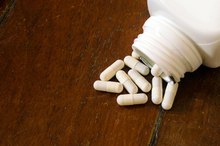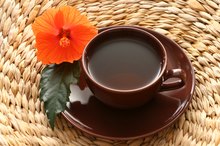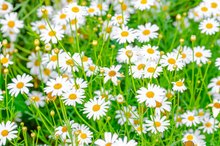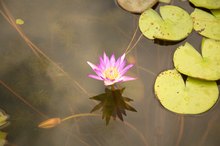Manzanilla Tea Benefits
Manzanilla tea is the Spanish name for chamomile tea. It is used to treat a variety of digestive ailments, as well as to promote relaxation. Drinking Manzanilla tea is relatively safe, but you should consult with a qualified health practitioner before using it if you suffer from any type of serious health issue or are taking other medications.
Manzanilla Plant
The Manzanilla, or chamomile, plant comes in two common varieties: Roman chamomile and German chamomile. Most research has been performed on German chamomile, but they are both used for similar medicinal purposes. The chamomile plant has white flowers and is similar in appearance to a daisy, although Roman chamomile has bigger flowers than the German variety. The white flowers, and their yellow centers, are used as a medicine, most often in the form of a tea.
- The Manzanilla, or chamomile, plant comes in two common varieties: Roman chamomile and German chamomile.
- The chamomile plant has white flowers and is similar in appearance to a daisy, although Roman chamomile has bigger flowers than the German variety.
Traditional Uses
The Side Effects of Echinacea Tea
Learn More
The traditional uses for Manzanilla tea are similar throughout the world, usually based on the plant's anti-inflammatory properties -- generally attributed to the terpenoids and flavonoids present in the plant. Some comment ailments treated include:
- digestive issues
- hemorrhoids
- anxiety
- insomnia
- skin problems
- such as eczema
According to Martha Libster, author of "Delmar's Integrative Guide for Nurses," using a Manzanilla tea infusion for female issues is very common in the Hispanic culture 3. Commonly treated issues include menstrual problems, labor pains and, together with other herbs, cleansing after childbirth.
Modern Research
Few studies have been performed on humans using Manzanilla tea, according to the University of Maryland Medical Center, but studies on animals have validated some of its traditional uses 12. Those include inflammation, speeding of wound healing, reducing muscle spasms and serving as a mild sedative to help induce sleep.
Making Tea
Neem to Kill Human Intestinal Parasites
Learn More
To make Manzanilla tea, the University of Maryland Medical Center recommends pouring 1 cup of boiling water over 2 to 3 heaping tablespoons, or about 2 to 4 grams, of the flowers and steeping the infusion for 10 to 15 minutes 12. It is best to drink the tea between meals. Many over-the-counter brands of prepackaged Manzanilla tea are available as well. Be aware, however, that some of the premade teas contain other herbs in addition to the Manzanilla flower.
- To make Manzanilla tea, the University of Maryland Medical Center recommends pouring 1 cup of boiling water over 2 to 3 heaping tablespoons, or about 2 to 4 grams, of the flowers and steeping the infusion for 10 to 15 minutes 1.
- Be aware, however, that some of the premade teas contain other herbs in addition to the Manzanilla flower.
Potential Problems
Drinking the occasional cup of Manzanilla tea is considered relatively safe, according to the University of Maryland Medical Center, but if you plan to use it as a medicinal several times a day, consult your doctor first 12. Manzanilla, or chamomile, is a flower, so people with asthma or allergies to ragweed, daisies or similar plants should avoid it. If you notice any type of allergic reaction -- such as sneezing, skin rash or trouble breathing -- discontinue use and call a qualified health professional immediately. Because of the risk of miscarriage, pregnant women should not drink Manzanilla tea. Anyone with a history of breast or ovarian cancer should check with their physician before drinking the tea.
- Drinking the occasional cup of Manzanilla tea is considered relatively safe, according to the University of Maryland Medical Center, but if you plan to use it as a medicinal several times a day, consult your doctor first 1.
- Anyone with a history of breast or ovarian cancer should check with their physician before drinking the tea.
Related Articles
References
- University of Maryland Medical Center: Roman Chamomile
- University of Maryland Medical Center: German Chamomile
- Delmar's Integrative Guide for Nurses: Martha Libster
- Srivastava JK, Shankar E, Gupta S. Chamomile: A herbal medicine of the past with bright future. Mol Med Rep. 2010;3(6):895–901. doi:10.3892/mmr.2010.377
- Chang SM, Chen CH. Effects of an intervention with drinking chamomile tea on sleep quality and depression in sleep disturbed postnatal women: a randomized controlled trial. J Adv Nurs. 2016;72(2):306-15. doi:10.1111/jan.12836
- Memorial Sloan Kettering Cancer Center. Chamomile. Updated February 1, 2019.
- Health National Center for Complementary and Integrative Health. Chamomile. Updated September 2016.
- Colombo D, Lunardon L, Bellia G. Cyclosporine and herbal supplement interactions. J Toxicol. 2014;2014:145325. doi:10.1155/2014/145325
Writer Bio
Solomon Branch specializes in nutrition, health, acupuncture, herbal medicine and integrative medicine. He has a B.A. in English from George Mason University, as well as a master's degree in traditional Chinese medicine.









